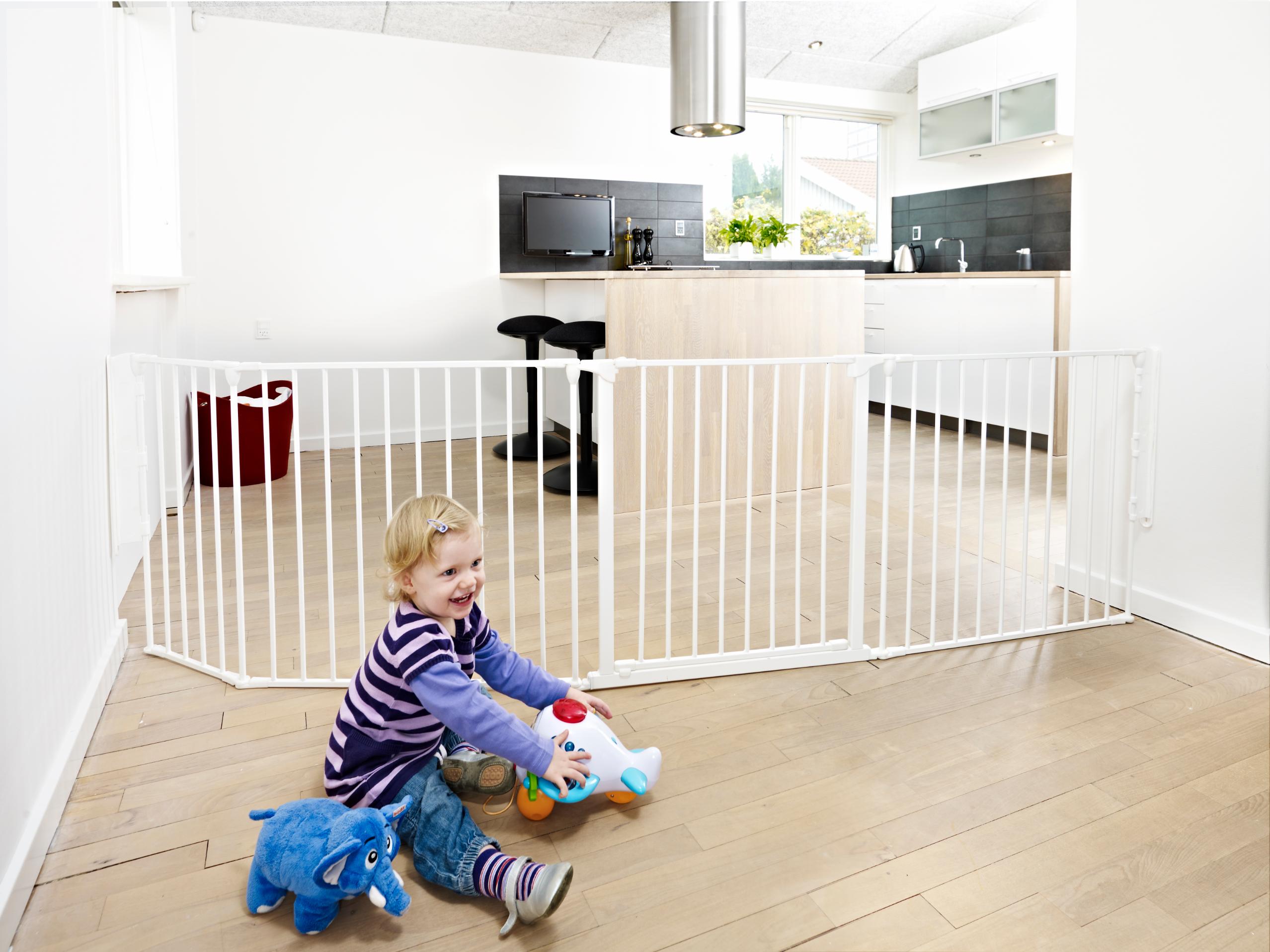Test, test, test!
When we at BabyDan say that we want to be a leader in child safety products, we mean it. That is why we do our utmost to make sure our products are among the safest on the market, so they can help you take care of your child.
To achieve this, our products undergo comprehensive and vigorous testing in our BabyDan Test Centre, so you and your child can feel comfortable using our products.
BabyDan safety gates are some of the world's safest safety gates - and we work every day to make sure they stay that way. We therefore test our gates both at our own BabyDan Test Centre and at external European and internationally accredited testing institutes such as TÜV and Bureau Veritas.
Below you can read more about what tests we use on our safety gates and why.
We test in order to give you the best products
We at BabyDan want to be a leader in child safety products. That is why we test our products in our BabyDan Test Centre, so they can help you take care of your child.
Why are we testing our safety gates?
We test all of our safety gates to make sure they help prevent your child from getting hurt at home. We also test because we are a responsible manufacturer of safety gates, and we want to be certain that you are getting the best help to take care of your child.
When we test our gates, we test based on the testing standards used by the authorities. These are testing standards that European safety gates must undergo in order to comply with safety standards EN 1930 and EN 71.
When a safety gate complies with one of the safety standards, you can be absolutely confident that the gate will help keep your child safe. You can be sure of this because you know that the safety gate has undergone a variety of tests to investigate whether the gate can withstand different scenarios from daily life.
The safety standards are based on thousands of statistics about children, their size, weight and how they behave. That is why we use the current European and American tests, to make sure that we always offer you the safest and best safety gate.
How often do we test?
Every week, we test selected safety gates in our own BabyDan Test Centre. We test our gates again and again, so that you can always feel confident you are getting the safest safety gate. Each test is performed in turn by four employees, to ensure that we are as meticulous as possible.
It is one of BabyDan's core values that we will give you the absolute best conditions for taking care of your child. We therefore test beyond what is required by authorities and testing standards, so we can be 1000% sure that our gates are the best in the world.
For this same reason, we test the gates both internally at our BabyDan Test Centre and externally at European and internationally accredited testing institutes. It is not a legal requirement that safety gates must be tested internally by the company, but we have chosen to do so because we go the extra mile for children's safety.

BabyDan Test Centre’s 8 tests
We use many different tests to make sure that the safety gate is can withstand taking care of your child. On a given day, the child will certainly push it, try to crawl on it, pull it and throw toys at it.
The safety gate must be able to withstand that and much more. Consequently, we have eight different tests that simulate a child's actions.
Basketball Test
If your child runs into the safety gate, the gate must stay upright. It might also occur that the child drives into the gate on his or her balance bike or toy car, and rams into it at a high speed. No matter how and at what velocity the child bumps into the safety gate, it must be able to withstand that collision.
We therefore test all of our safety gates with a Basketball Test, which entails a basketball weighing 10 kilos bumping hard into the gate 28 times. We do this to investigate whether the gate can be toppled over or dislocated. We test several different places on the gate, so we are certain that the gate has no weak points.
Rattle Test
Children are curious and love to explore and learn. Your child will therefore almost certainly be curious about what is on the other side of a safety gate. This can lead the child to shake the gate and this is naturally something the gate should be able to withstand.
A Rattle Test replicates the motions of a child who is shaking and pulling on the safety gate. The test instrument simulates a hand shaking the gate for 8 minutes. The simulated shaking of the gates is carried out with special equipment. So we can be certain that the safety gate can handle all the pushes, pulls and shakes that it may be exposed to in the course of any given day.
Push-Pull Test
Some kids are little escape artists who will make every attempt to get to the other side of the safety gate. At the BabyDan Test Centre, we therefore test all our gates with a Push-Pull Test, which simulates a child trying to get out.
The test mimics a child pulling as hard as they can on the gate. The robot pushes with 14 kilos and repeats the motion back and forth 10,000 times. It takes about a day to complete the test. We use this test to make sure that the child cannot dislodge the safety gate in any way.
Test for spacing between bars
Kids are inquisitive and will probably examine a safety gate by sticking their hands through the bars. It can be dangerous if a child is able to get their body through the bars, and especially if the child gets his or her head stuck between the bars.
We consequently test the spacing between bars on all BabyDan safety gates. So we can be certain that the child cannot get in between the bars and risk getting stuck. The test is performed with a special cone shaped instrument and tested with a force of 30N.
Finger entrapment
Getting fingers caught is always unfortunate. Unfortunately, getting little fingers caught is something that most children will experience at some point. It can be quite painful and could be dangerous.
We want to prevent your child from getting his or her fingers caught in our safety gates. To prevent this from happening, we test for whether it is possible for little fingers to get caught in our safety gates. We test the gate at all angles, so we are absolutely sure that no little fingers will be pinched.
Foot Step Test
Whether you are using a safety gate in a doorway, hallway, at the bottom of the stairs or at the top of the stairs, it is imperative that your child cannot get a foothold and then crawl over the gate.
That is why we test our safety gates with a Foot Step Test, which ensures that a child cannot stand on the baseplate and crawl over. The height of the safety gate is at least 65 cm, so you can rest assured that your child will not be able to climb over it.
Small Parts Test
Most parents know that children tend to put everything into their mouths. It is therefore extremely important that your child cannot put things into his or her mouth that might get lodged in the throat. This can pose a risk of suffocation. All BabyDan safety gates are therefore tested to see whether small parts can be pulled off the gates.
Tests for hazardous substances
When you have young children in the home, there should not be anything within reach that contains harmful chemicals. Young children will often suck and bite new things as a way of exploring their surroundings.
They will do this with almost anything, from their hands to a toy. When setting up a safety gate, the child will almost certainly want to explore the gate to determine what it is.
For this reason, we always test our safety gates for hazardous substances. It is crucially important that your child does not ingest any undesirable and health hazardous substances when he or she is sucking on the gate.
It is practically unavoidable that your little one gets the notion to try sucking and biting it - and of course we need to make allowances for that. Our BabyDan safety gates are so safe that your child can suck on them without ingesting any harmful chemicals.
Member of committees that makes testing standards
BabyDan is proud to be a member of the S-286 Committee, which makes the testing standards that European safety gates must carry out to comply with safety standards EN 1930 and EN 71.
It is currently voluntary whether companies test their safety gates to the applicable testing standards. At BabyDan, we think that testing safety gates ought to be a legal requirement. This is exactly why we helped create the European testing standards that are in force today.
We are still on the S-286 committee, so we can continue to make testing standards even more stringent - and make sure all children are safe in their homes.
When a safety gate complies with one of the safety standards, you can be certain that the gate is safe for your child. This certainty and trust derives from the fact that the safety gate has passed a wide array of tests and has been tested from every angle and conceivable scenario which the gate could be exposed to during daily use.
The committee works to make safety gates as safe as possible, by setting requirements for safety gate testing standards, user manuals and warning labels.
BabyDan is also a member of the S-256 committee, which determines the safety standards that furniture and other types of inventory must adhere to. You can read more about the different safety standards here.
Tests are only one side of the coin; the other side of the coin is proper mounting
All BabyDan safety gates have been tested, but they can only help you prevent your child from being injured if they are properly fitted into place. It is very important that you mount your safety gate properly to prevent accidents.
That is why we have made it as easy as possible for you to mount your gate. One thing we have done is equip all pressure mounted safety gates with a safety indicator, which shows you when you have mounted it correctly.
You can also use our Onbox app for all kinds of safety gates. You can download our Onbox app here.


